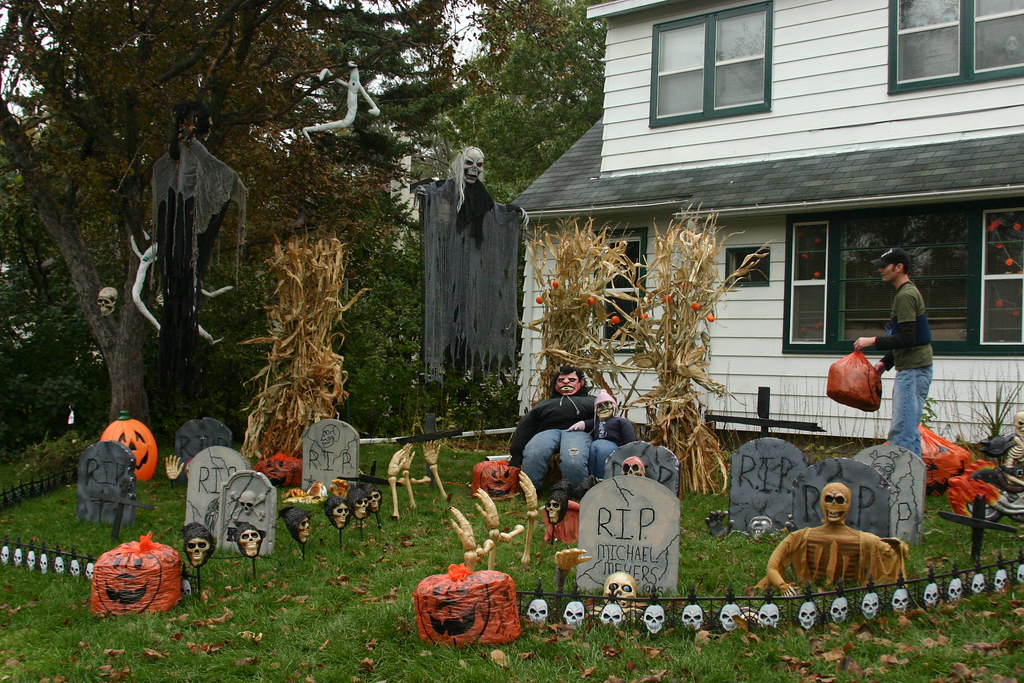Pennsylvania has bestowed, thus far, a warm and sunny autumn upon us. As my husband and I venture out on our evening walks, we are met with all the beauties of a gentle autumn: slowly changing trees shimmering with golden light, their fallen leaves softly gliding in the breeze as citrus-colored dusk drips down between the houses and trees. But we also routinely encounter more disturbing sights on our walks as we pass porches and yards full of Halloween “decorations.” Grim reaper figures, zombie representations with tattered clothing, enormous inflatable black widow spiders, larger-than-life skeletons bending over the sidewalk where we stroll.
These expectable figures seem to me to be more than mere seasonal decorations. Rather, they are emblems, indicating certain attitudes and understandings in our culture: they signify our contentment with cheap garish caricatures of death as well as our unspoken understanding of life beyond death.
In my upbringing in suburban Maryland and in my college years in rural Pennsylvania, I have hardly seen such a magnitude of figures and inflatables as I have this year. The yards of otherwise-sweet-looking duplexes and humble Cape Cods crawl with them, these figures of the garish, the eerie, and the undead. While the volume of such figures here may be due to the variations in character between the Philadelphia suburbs and other places I have lived, it may also owe to an increasing cultural appetite for the garishness such figures signify.
While pumpkins and tacky “hello fall” signs and smiling scarecrows from Hobby Lobby suggest a spirit that takes joy in the marks of the harvest season, figures of the garish—skeletons, zombies, reapers with their scythes—represent a spirit fascinated primarily with the death that autumn brings. For this season brings with it not only the golden days of changing leaves but also the chilly nights of fog and howling wind—not only the beauty of harvest hues but also the ugliness of the dying grass and dry leaves.
As we witness the grim approach of winter, we tend to resonate with the words of Jeremiah the prophet: “The harvest is past, the summer is ended, and we are not saved.” In autumn, tree branches become “bare ruin’d choirs,” in the words of Shakespeare. It is the time of year in which we see marks of death or of death’s coming and, in the words of Dante Gabriel Rossetti, the time in which “death seems a comely thing.” The prophets and poets know that, come autumn, death is all about us. Thus the “spooky” aspect of our modern attitude towards the autumn season sprouts not merely from folk traditions but from the season itself, from the eeriness that naturally abounds in the death of the year: there is, perhaps, some kernel of truth buried in the gruesome getup of Halloween.
Clare Coffey argues similarly in an essay about spooky season and Advent entitled “Waiting in the Gloom.” She describes autumn’s eerie aura thus:
It is the season of graveyards, of the wet brown leaves rotting in the compost, suffering what they must so that life will return in spring. It is the foreboding of winter. It is the knowledge of your own death, hurtling toward you faster than you would like to admit. Not only your own—it is the season when the earth and everything seen and unseen on the earth turns on you with the same hostile reproach: we are dying, dying, because of you. If the golden harvest marks the high point of our comity with nature, our sitting down together at table, the spooky season is the late point in the night when tempers begin to unravel, when the contentment of the moment gives way to the old grudges underpinning everything: the bitterness and shame of that first traitorous act of our regency, all the envies and enmities and ambivalences of things older and more powerful than we are.
The decorations that pop up around our neighborhoods in mid-September (or even earlier) indicate our eager embrace of this deathly, bitter side of autumn. We are ready to rush past the happy late-summer and harvest bits of fall to meet and revel in its spookiness (and then to rush on towards the commercial sense of satiety that comes with Christmas).
Yet it should be no surprise to us that, while there is a true death and a true eeriness to be recognized within autumn, our culture overlooks the deep meaning of such death and replaces it with a shallow commercialism, a gluttonous intake of garishness. Coffey suggests that the spooky season’s deep meaning is the judgment wrought by human sin. Our culture’s celebration of Halloween—through its obsession with cheap frights and jump scares and disturbing images—obscures this meaning. The death and darkness figured in autumn is distorted by the figures of death that abound about us.
Nonetheless, even the skeletons in the neighbor’s yard suggest that we all recognize the reality of death, the reality of our share in Adam’s curse. While the memento mori artwork of Christendom may do so much more beautifully and nobly, even plastic skeletons suggest our inherent sense of our finitude.
But our culture’s celebration of Halloween suggests that we know yet more. We sense not only that we are dust and will return to it; we also sense that life exists beyond death. Why else would undead figures such as ghosts and zombies feature so profoundly in our autumnal lore, in contemporary culture as well as across times and cultures? Our current culture, again, cheapens and distorts the reality of the “undead” even while recognizing it.
A yard in my neighborhood boasts faux gravestones captioned with pithy lines aiming at creepiness. One gravestone recently caught my eye: in shaky capital letters, the decoration reads “The Dead Will Be Raised.” While the piece of plastic is ironic, those who positioned it in the yard are pitiable. They may joke about the undead, but the resurrection of the dead is not a myth to be mocked at Halloween. It is a reality that both blooms with hope and looms with dread. We will be raised, either to everlasting life or everlasting death, as the prophet Daniel recorded: “many of those who sleep in the dust of the earth shall awake, some to everlasting life, and some to shame and everlasting contempt.”
Coffey advocates in her essay that we see Advent as the culmination of spooky season and Christmas as the “end and reversal of spooky season.” The motifs of death and deathlessness that we encounter in our Halloween lore and ornaments are played out most fully and satisfyingly in Christ’s coming. Our cheap decorations are but a meager yearning after that most strange and unearthly of stories, of the one who created life taking on death and being raised to deathless majesty and so raising those who feed on him. No wonder the Romans called the early Christians cannibals—this is a harrowing and haunting tale. But it is a true myth, the myth that became fact (to borrow from C.S. Lewis), the myth to end all myths.
Perhaps we ought not turn up our nose at our neighbors’ yards this year. Perhaps compassion is a better response than disgust: they do not know what they are missing, what goodness they are twisting. The Christian story is, in truth, a much more chilling and fulfilling tale than any spooky story we can muster.
And for ourselves, perhaps even before Advent begins, we ought to begin meditating the shadow of death which we dwell in, thanks to Adam, and the light that threatens to dawn upon us.
Image via Flickr




